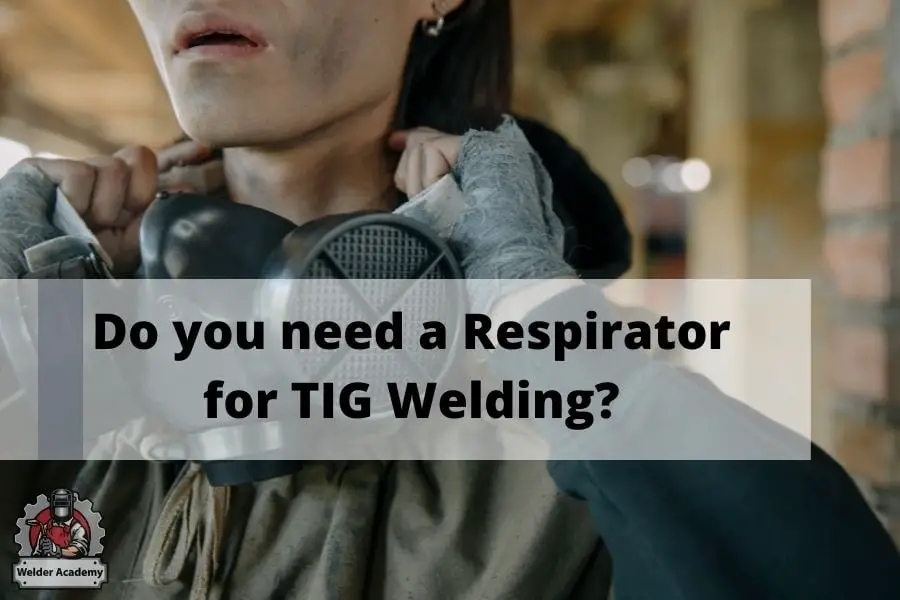
Just like another type of welding, TIG welding also comes with its risks and hazards. Exposure to toxic fumes that are released when metals are molten is a major danger associated with TIG welding. Breathing in these fumes can be quite deadly, hence a question arises, do you need a respirator for TIG welding?
Using a powered air-purifying respirator is required to reduce the chances of getting ill from toxic fumes such as chromium and cadmium. Developing cancer is the biggest concern when a respirator isn’t used during TIG welding materials like stainless steel.
Since this is a matter of safety, time, and money, I understand that you want to learn more about this. Thus, without further ado, I advise you to keep scrolling and find for yourself, the more intricate details about the matter at hand.
Is TIG Welding Dangerous?
Yes, TIG welding without the proper protective gears can be very dangerous. It can cause suffocation and produce a lot of airborne toxic elements.
Let’s recap on how TIG welding works for a second for any beginners or newcomers who have just started or are planning to start the welding business. TIG stands for Tungsten Inert Gas. You’re welding materials by forming a welding arc within the material and the tungsten electrode in TIG welding. Electricity is a major contributor to create this arc for TIG welding.
To protect the welding piece and the tungsten electrode from oxygenating, inert gases such as argon are used. It is specially used for alloys, nickel, stainless steel, and aluminum for industrial constructions, pipelines, or aerospace applications. Pretty much a welding category that leans more towards the science stuff.
Now, how does this make them dangerous? I’ll soon just name the two types of respiratory dangers associated with TIG welding. I’ll advise not to neglect the dangers that will be discussed below. Consider them quite crucial as safety is concerned here. Hence, TIG welding can cause alarming concerns regarding respiratory health.
The inert gases can certainly help the tungsten electrode and materials stay free from oxygenation. However, it can also make you suffocate in the process. The shielding gases can easily displace oxygen from reaching you that can make you feel dizzy, nauseous, and even make you faint while in the middle of welding. Ouch on that!
Also, while welding the molten substance, you are easily subjected to inhaling metal molecules and ozone gases. These are toxic and can cause prolonging health concerns. To learn more about this, please keep reading further as a lot more elaboration is needed.
Why Should You Wear A Respirator While TIG Welding?
While TIG welding, you are welcomed by the release of small, toxic nano-particles that are known as ozone. Asides from that, you have toxic metallic fumes coming off from the materials that you TIG weld, usually aluminum or stainless steel. This makes it a requirement for you to wear a respirator while TIG welding.
Let’s clear out the ozone first. These nano-particles are small enough to penetrate the likes of barriers in your respiratory system and simply cause havoc once it’s inside your bloodstream. These particles are mostly gases that have been produced due to the mixture of electrode arc and shielding gases all being cooked up by UV rays during the welding process.
Inhaling harmful gases like Carbon Monoxide, Ozone, Nitrogen, Phosgene, etc. are also considered to be nano-particle intoxication. Coughing, suffocating, shortness of breath, and some cancer risks are associated with their particles. source.
On the other hand, off-gassing from the materials you’re melting is also a respiratory concern. These gases are produced from the welding process that takes place between the rod, electrode, and the respective metal you are welding.
Speaking of metals that are welded, stainless steel can generate fumes of chromium and cadmium that can cause chronic kidney damage and risk the chances of having cancer. If considering aluminum, then fumes of arsenic, fluorine, and copper are produced that can lead to metal fume fever.
Furthermore, the usage of TIG inert gases like argon can at times cause the oxygen depletion level to drop and cause asphyxiation to take place. This was mentioned previously and the reason I’m mentioning it again is that the solution to this while also avoiding inhaling the toxic fumes all lies in the hands of a respirator.
And that is why you should use a respirator if you’re a TIG welder. These respirators can vary in kind and functionality. However, what they do is quite simple, provide a proper inner ventilation system for you that keeps the toxic particulates away from you. They can also protect you from asphyxiating by providing you with oxygen.
Some respirators with helmets and filters on can also protect you from UV radiation. To learn more about respirators and choosing the right kind, I advise you to proceed to the next section.
Choosing the Right Respirator for TIG Welding
Though in some cases you will be provided with proper ventilation and appropriate work practice, it is still quite vital that you consider that this may not always be the case. At certain work conditions and spaces where there are limitations to natural ventilation, it’s up to you to rely on respirators.
Now, if you are working with TIG welding as a job then you will probably be given a respirator. If you weld as a hobby then you’ll have to buy one. Whatever the case might be, here are the different types of respirators that work well with TIG welding.
Disposable Half Facepiece
Any disposable masks can provide sufficient protection from dust particles and larger fumes. Though they are cheaper, lightweight, and can be worn under helmets with ease.
They are only the usual choice when you work in open, well-ventilated areas and the risk of inhaling fumes is far less. A 3M or N95 mask will do just fine.
Half-Mask Reusable Respirators
These come with various options for sizes and filters and have replaceable parts. They are lightweight and their moderate cost makes them ideal for cheap yet effective protection.
However, these respirators don’t block all sorts of fumes. Pairing these with well-ventilated workspaces and proper distance will provide sufficient protection.
Powered Air Purifying Respirator (PARPs)
This is personally the best option in terms of respiratory protection out of all. It is portable and is the best option for a spacious workspace with little to no open space for ventilation.
They do not draw any of the air from the toxic fumes and instead rely on battery-powered filters positioned on your back.
The filters supply clean air to your respirator which accounts for no breathing resistance. Though they can be quite expensive and need proper training and maintenance to be usable, they surely will reduce any sorts of respiratory dangers while welding. Flowing cool air over your face surely adds to added comfort when working in hot spaces.
Supplied Air Respirators
This is a better option if you’re more concerned about protection against nano-particles. Welding is very narrow and claustrophobic spaces will surely require you to own one of these. While they surely affect your mobility, they still can supply you with the coolest and fresh air.
These respirators have a compressor that draws in fresh and safe air from uncontaminated areas. Wearing compressors will pump clean air to your respirator through an airline. They go through several levels of filtration, controlled flow, and cooling to provide you proper ventilation.
To utilize these respirators, you will be required to maintain these units, take proper training and spend some extra money. Looking forward to ordering respirators online? If yes, then check out this Half Facepiece Reusable Respirator 6300 an Amazon.
Conclusion
Learning more about safety is always a good step towards ensuring a long life. Hoping you have gathered sufficient knowledge that answers your concerns regarding whether or not, do you need a respirator for TIG welding.
I wish you good luck in your welding adventures ahead and thank you for reading.
